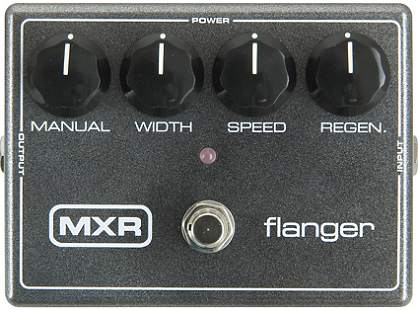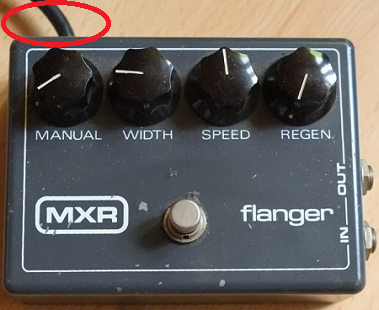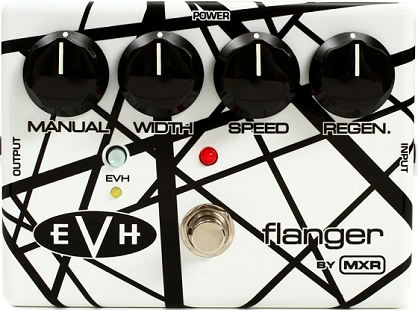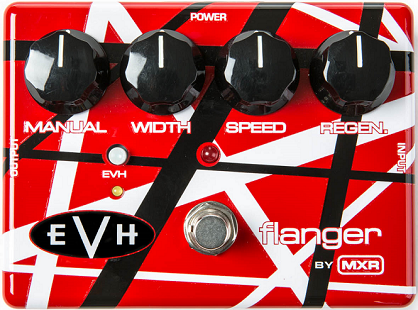M117R Flanger
The MXR M117R Flanger. This is a flanger that you've heard on all kinds of recordings, but the person who really made it famous was Eddie Van Halen. This effect can be and has been used, not just in heavy music, but across all kinds of different music genres. Unlike the impression that the famous EVH "Swoosh" probably gives when you first hear it, the M117R Flanger is an effect pedal that can also be used very subtly and tastefully.
While this wiki entry encompasses multiple versions of the flanger, we describe those different versions so searches will arrive here too. We think this is preferable to posting multiple entries for what is essentially the same pedal.
If you've followed our site for any length of time, you're probably aware that we do not care for any kind of specific artist-editions of any kind of equipment: instruments, pedals, amps, etc... We think it's important to point out that our favorite artists only got artist-edition equipment AFTER they became famous. Everything they did to get famous was on standard version equipment that they played or tweaked-and-played themselves.
...But then we're human beings too. In a few rare instances, we'll defy our better judgment and grab a limited edition version when we happen to find a good deal on eBay (or elsewhere). On our own personal pedalboards, you'll actually find the standard M117R flanger.
Thermionic Studios owns four (4!) copies of this pedal. We have two of the standard M117R version, one EVH117, and one EVH117SE. Please feel free to contact us if you're interested in renting one.
Controls

- Knob 1 - "Manual": This knob changes the centerpoint of the sweep of the flanging effect. Turn clockwise to increase the tonal frequency "area" inhabited by the sweep.
- Knob 2 - "Width": This knob controls the "width" of the sweep of the flange. Turning the knob clockwise to increases that width of the sweep.
- Knob 3 - "Speed": This controls how quickly the swell traverses the width of the flange. This control is also "zeroed-out" when the Width control is turned all the way down.
- Knob 4 - "Regen": This knob controls the intensity of the flanging effect. Turning completely counter-clockwise makes the flanging effect very faint. Clockwise increases the strength of the effect.
The Width knob is pretty interesting in its function and how it works on this pedal is worth remembering. Turning the knob completely counter-clockwise removes the Width control from the flanging effect. Alternatively, turning the knob completely clockwise removes the Manual control from the effect.
Tricks
This flanger, unlike most others that we're aware of, has a couple of tricks that you may find helpful:
- Set the sonic space of where you want your flanging effect to sit:
This sounds a little odd, but it's actually pretty cool. With the WIDTH set completely counter-clockwise, there is no "motion" in the flanging effect. This also means then that when the WIDTH is set to "zero" that the MANUAL knob becomes far more useful. Doing this, if you play the instrument and listen, you can get a sense of where, sonically, you want the flanging effect to sit. Once that's decided, you can then adjust WIDTH, SPEED, and REGEN to get the preferred flanging effect "coloration" you want on your tone.
- Why the first knob is called MANUAL:
With the WIDTH set all the way off, if you turn the MANUAL knob back and forth while playing, you'll notice you're invoking a manual sweep of the flanger effect. Here at Thermionic Studios, we've actually thought it would be a really cool idea to put such an effect into a treadled pedal (like a Wah-wah) so you could control your flanger swooshing effect in the same way you can control a wah-wah "crying" effect.
Bypass: Buffered
Most Dunlop/MXR pedals have a high-quality (non-audible) buffer in their design. All versions of the M117/EVH117 also use buffers.
General Information
One of the bigger innovations that made the original M117 Flanger so lush in 1978, when it was released, was that unlike other companies who had built theri flangers using only a 9-volt power supply, the original MXR M117 Flangers employed a built-in AC power cord (circled in red) that was plugged into a standard 110-120 volt AC wall outlet. This allowed the engineers at MXR to build a much higher headroom flanger effect, which in turn provided the opportunity for more spacious sounds.

Copyright of image not found. Presumed Public Domain.
The modern retooled version, the M117R, attempts to carry on that tradition (at least somewhat) with under-side access for two 9-volt batteries, or an 18-volt AC power adapter at the top.
"Vintage" versions of the M117 Flanger can still be found for what we believe are still "reasonable" prices - especially when compared to Vintage Electro-Harmonix Electric Mistress flangers. But we also don't happen to believe that the vintage versions of the M117 Flanger sound so much better than the reissue model that it's worth bothering about.
Pedal Manual(s)
EVH117 Flanger

This is the original Eddie Van Halen version of the MXR Flanger - built for him by Dunlop. It features the original "VH-I" black-stripes-on-white motif that Eddie used as his primary guitar. This version of the pedal differs from the standard M117R in that it offers an "EVH Button" that instantly dials in Eddie's favorite flanger setting.
We own a copy of this model because we thought it would be cool to pair with our 2-color black-and-white EVH90SE 35th Anniversary Phase 90 phaser pedal.
EVH Button
- Button 1 - "EVH button": Depressing this button (it's a toggle) overrides the pedal's knob settings and activates the settings preferred by Eddie Van Halen. This provides the familiar "And The Cradle..." or "Unchained" swoosh.
Eddie's Swoosh
The EVH Button alone will not necessarily get you the Van Halen "Swoosh"...
One of the things that many players hunger to emulate but don't know how to get is the famous Eddie-Van-Halen-Swoosh (note to wiki staff: get an audio clip of the first 4 seconds of "And the Cradle Will Rock" and link it here). Most players can get close, but there's "something" about the EVH sound that makes the flanger effect so much more pronounced than what usual signal chains can provide. Most of the time, people have come to believe and accept that the reason they can't emulate this sound is because it was added after the track was laid down.
This is incorrect. We have recreated this sound and can do it faithfully.
The secret is to put the flanger pedal in between the guitar and the distorting amplifier. There is something about the distortion, and especially (at least according to our ears) the tube distortion that accentuates the effect - really brings it forward. We wondered about this when we were looking at some stage and pedalboard pictures of early Van Halen concerts and noticed that what EVH has previously said about his pedals appeared to be true - "just a piece of plywood" with his MXR Phaser, Flanger, and 6-band EQ. It then dawned on us that EVH probably did to the flanger what he did to his phaser.
So we put the flanger into the distortion. Eureka! We'd found the sound!
EVH117SE Flanger

The 35th Anniversary Special Edition or "EVH117SE" was released with what we would consider a motivation to pleasing those who might want to buy a vanity version of the MXR Flanger. Jim Dunlop issued the EVH 35th Anniversary version of the original MXR EVH117 Flanger. The only thing separating this Flanger from the EVH117 is the paint job and a "high gloss" finish. Otherwise, the EVH117SE is exactly the same as the standard edition EVH117 Flanger with the additional "EVH button".
Just like the standard EVH117 Flanger, the 35th Anniversary version also includes the EVH Button.
We own a copy of this model because we thought it would be cool to pair with our 3-color red-black-and-white EVH90 Phase 90 phaser pedal.
Phase Inversion
Schematic
Artists
- Eddie Van Halen
- Randy Rhoads
- Frank Zappa
- Michael Anthony
- Stone Gossard
- Kerry King
- Additional Sources